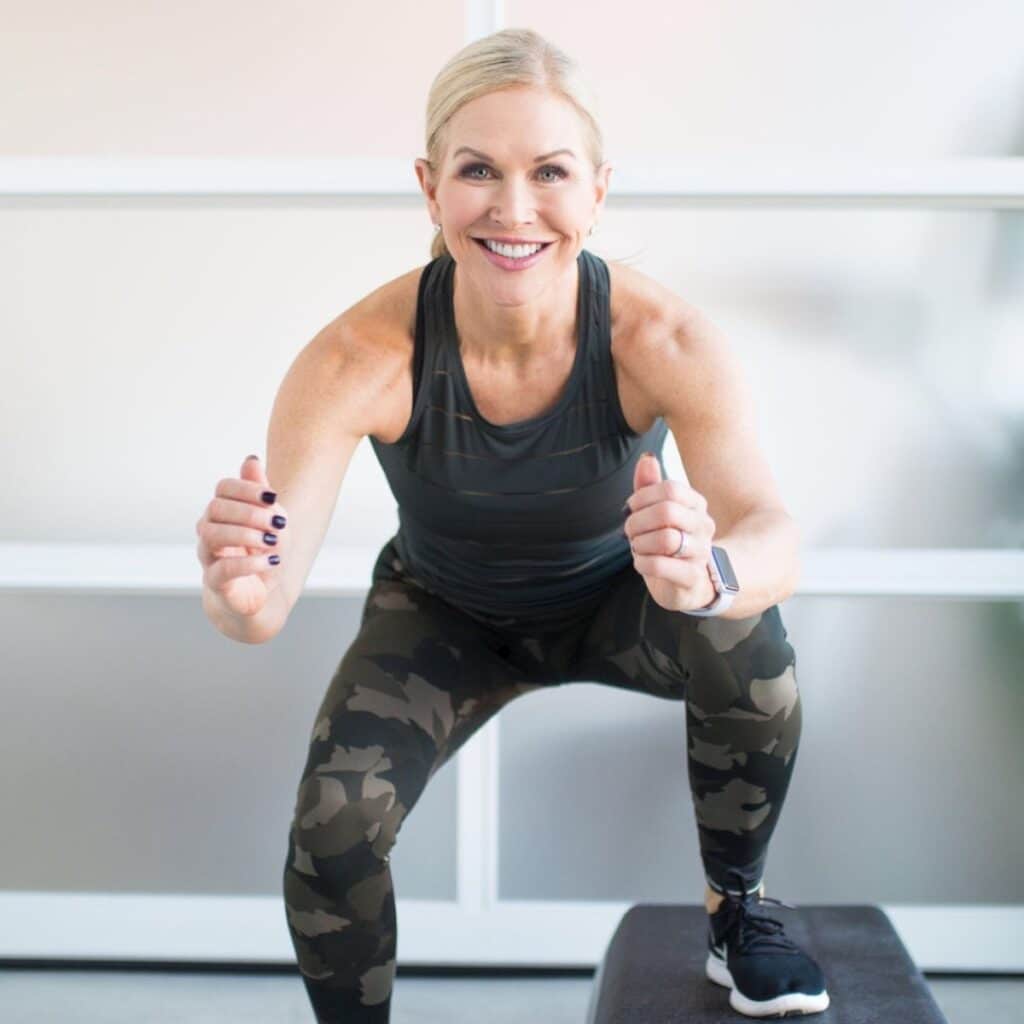This post contains affiliate links. Please see our disclosure policy.
Discover the ultimate guide to power walking for beginners! Learn the benefits, essential tips, and effective techniques to get started on your fitness journey with power walking. Perfect for all fitness levels!
Even as a fitness expert that does full intensity workouts many times a week, power walking is my ride or die fitness activity. With countless studies proving the benefits of walking, I love this form of exercise because it will keep you moving at any age.
Walking is one of the most maintainable workouts a person can add to their life. If you haven’t started power walking, the time is now!

Save This Article To Read Later
What Are the Benefits of Power Walking?
There are so many benefits to power walking. I define power walking as walking at a good pace, with good form for a certain amount of time or mileage.
Here are the top reasons why power walking is a wonderful choice of exercise:
- Power Walking Is Low Impact: Power walking gives you a great heart rate boost without wreaking havoc on your joints and connective tissue.
- Power Walking Burns Calories: Depending on the speed, a power walk can burn anywhere from 200 to 400 calories per hour or more. If you add a weighted vest for walking, you can burn even more! Check out my list of 7 proven ways to burn more fat while walking to up your intensity even more!
- Power Walking Is Important For Heart Health: It’s a great cardiovascular exercise working the heart and lungs.
- You Can Power Walk Anywhere: No equipment or special outfit is needed to walk! That means you can do it nearly anytime and anywhere. Comfortable clothes and choosing the right walking shoes are important, and a treadmill or walking pad can help in the colder months.
- Power Walking Is Suitable For Everyone: Obvious injuries or illnesses aside, walking is great for all ages, genders, sizes, and fitness levels.
- Power Waking Can Decrease Disease and Illness: Studies show that power walking can help decrease your risk of multiple maladies. Harvard Medical School says that walking improves cardiac risk factors such as cholesterol, blood pressure, diabetes, obesity, vascular stiffness and inflammation, and mental stress, just to name a few!
Tips for Getting Started With Power Walking
Power walking is a safe, low-impact form of workout but it’s still important to know to follow the proper power walking technique to avoid injury. These are my expert tips to get started with power walking in a safe way.
1. Stretch Before Power Walking
Yes, you do need to stretch, even before a walk. A power walk is an active exercise so you need to warm up those muscles. I recommend a dynamic stretching routine like these 8 Essential Stretches For Walkers.
2. Power Walking Warm-Up
A proper warm-up is crucial for all types of exercise including power walking. Begin slowly. Walk for a few minutes and then consider some active stretches such as 10 walking lunges and 10 hip circles. Studies show that a proper warm-up helps prevent injury.
3. Remember Moderation
Power walking too many miles can lead to an increased risk of injury and soreness. Don’t be tempted to start aggressively in an attempt to burn more calories.
If you are new to power walking, shoot for 15-20 minutes or less on your first endeavor. Do this for the first few times out. After a week of regular movement, increase your time to 20-25 minutes. After a couple more weeks, you will be up to a solid 30-minute walk.
The best place to start is with my power walking challenge.
4. Start Slowly
Just as walking too far your first time out can lead to injury or soreness, so can walking too fast. Make sure your first walk is moderate in pace. Just a stroll is fine.
A good way to judge? Walk with a buddy and carry on a conversation. If you can talk the entire time, you’re probably at a good pace.
5. Stretch At The End Of Your Power Walk
If you only have 30 minutes for a brisk walking workout, plan a 25-minute walk and save 5 minutes to stretch at the end. Stretching your calves, glutes, hamstrings, quads, and hips will help prevent soreness and keep you free from common walking injuries.
Using Proper Power Walking Technique
Power walking exercise recruits all kinds of muscles in your body. In order to prevent overuse injuries or poor form hazards, here are some good power walking form tips for you to follow.
- Good Posture: Stand tall. Pull your tummy in like you are zipping up tight jeans. Keep your head up and shoulders pulled back but relaxed. Lift your chest. If this is something you struggle with, give my posture exercises a try!
- Use Your Arms: Good arm motion will help you burn 5-10% more calories. Bend your elbows 90 degrees and keep elbows pulled in close to your body. Pump your arms straight forward, not diagonally, and be sure they stay low, not going past your breastbone. Make fists, but relaxed not tight.
- Foot Motion: Your footsteps should be in a heel-to-toe motion. Your heel hits first then your foot rolls through your toe.
- Keep Your Strides Natural: Don’t try to speed up by taking giant steps or an unnaturally long stride. Instead, lengthen your stride by your back foot by keeping that foot on the ground longer and giving you a more powerful stride forward. Don’t overthink it.
Power Walking Workouts To Get Started With
Prefer to follow along with a workout? Give one of my walking workouts a try!
More Power Walking Expert Tips
Here are some other helpful tips to keep in mind as you learn how to power walk.
Choose Comfortable Clothes
This one probably seems obvious, but the more appropriate the clothing the more comfortable you will be. And the more comfortable you are, the longer you will last. Choose not only based on the temperature you are walking in but the fabric of the clothing as well. Moisture-wicking fabrics designed for exercise will help your temperature stay regulated as well as to stave off chafing under your arms or between your legs.
The Best Shoes for Power Walking
Proper footwear will be your best friend as you start a new power walking program. Did you know that running shoes can be used for waking. The motion is very similar.
Pick a pair with good ankle stability, cushioning, and in my case, a wide toe box. Also a breathable fabric is important too. One of my favorite tips is to make sure there is at least a thumbs width of space between your toes and the front of the shoe.
Check out my entire guide on choosing the right walking shoes for even more tips!
Make A Plan
Don’t just open the door and go or hop on the treadmill without knowing what your intentions are. Whether you set a timer on your watch or plan a route on which you know the distance, be smart about your walk.
Follow Good Walking Form
Walking uses more than just your legs. Keep your shoulders back and chest lifted to avoid hunching forward. Pull your abs in as you walk and keep good posture. Leave your arms free from clutter so that you are able to swing them next to your side.
Find an Exercise Buddy
There’s nothing like a friend waiting on the corner to keep us accountable. Walking buddies can encourage one another and keep each other going. In addition, a walking buddy gives you an incentive to go further and makes the whole workout more pleasurable.
Track Your Progress
Whether you use a fitness app, smartwatch, or other fitness trackers or go the old-fashioned route and write it on your calendar, it is important to track your progress.
Not only does this help you increase your pace and mileage, but it also motivates you as you see how much better you’re getting! Aim for four to six power walks a week. Beginners should strive to stride for 20 to 30 minutes. More experienced walkers can step it up to 45- or even 60-minute sessions (when time allows).
Remember the tip about starting slowly! A good rule of thumb is to gradually increase your walks by 10% each week.



I love walking, but this article helped me to know how to get most benefits from walking.
In pick up the pace you suggest : “Strive for 15mph to 18 mph.” …. Thats almost sprinting! Surely 1.5 – 1.8mph building to 4.5mph?
Thank you for pointing that out – indeed a typo and I fixed it!